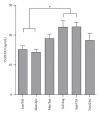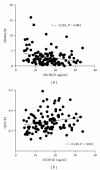Vitamin d deficiency in obese children and its relationship to insulin resistance and adipokines
- PMID: 22254134
- PMCID: PMC3255292
- DOI: 10.1155/2011/495101
Vitamin d deficiency in obese children and its relationship to insulin resistance and adipokines
Abstract
Low-serum concentrations of 25-hydroxyvitamin D [25(OH)D] are associated with insulin resistance in adults. Less data are available in pediatric populations. Serum 25(OH)D serum concentrations were assessed in 125 obese and 31 nonobese children (age 11.9 ± 2.7 y, range 6-16 y, 49% male) living in Bonn, Germany. The relationship between 25(OH)D, measured by liquid chromatography-tandem mass spectrometry, and measures of insulin sensitivity and adipokines adiponectin and resistin were analyzed. Seventy-six % of subjects were 25(OH)D deficient (<20 ng/mL). Higher insulin, homeostasis model assessment-insulin resistance (HOMA-IR r = -0.269, P = 0.023), and hemoglobin A1c (HbA(1c)) as well as lower quantitative insulin-sensitivity check index (QUICKI r = 0.264, P = 0.030) values were found in obese children with lower 25(OH)D concentrations even after adjustment for gender, age, and body mass index. Furthermore, 25(OH)D correlated significantly with adiponectin, but not with resistin. Our results suggest that hypovitaminosis D is a risk factor for developing insulin resistance independent of adiposity.
Figures



References
-
- Kaufman FR, Shaw J. Type 2 diabetes in youth: rates, antecedents, treatment, problems and prevention. Pediatric Diabetes. 2007;8(9):4–6. - PubMed
-
- Rajakumar K, Fernstrom JD, Holick MF, Janosky JE, Greenspan SL. Vitamin D status and response to vitamin D3 in obese vs. non-obese African American children. Obesity. 2008;16(1):90–95. - PubMed
-
- Bradlee ML, Singer MR, Qureshi MM, Moore LL. Food group intake and central obesity among children and adolescents in the Third National Health and Nutrition Examination Survey (NHANES III) Public Health Nutrition. 2010;13(6):797–805. - PubMed
-
- Muscogiuri G, Sorice GP, Prioletta A, et al. 25-hydroxyvitamin D concentration correlates with insulin-sensitivity and BMI in obesity. Obesity. 2010;18(10):1906–1910. - PubMed
-
- Targher G, Bertolini L, Scala L, et al. Associations between serum 25-hydroxyvitamin D3 concentrations and liver histology in patients with non-alcoholic fatty liver disease. Nutrition, Metabolism and Cardiovascular Diseases. 2007;17(7):517–524. - PubMed
Grants and funding
LinkOut - more resources
Full Text Sources
Miscellaneous

